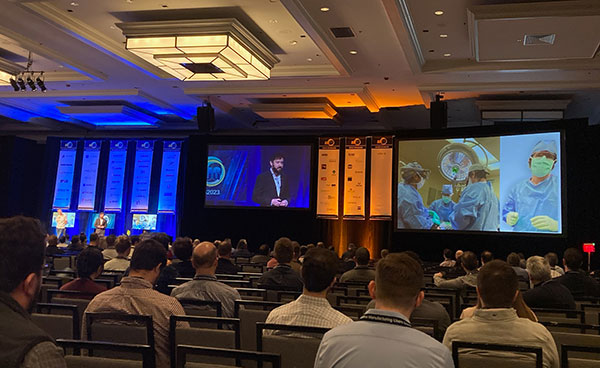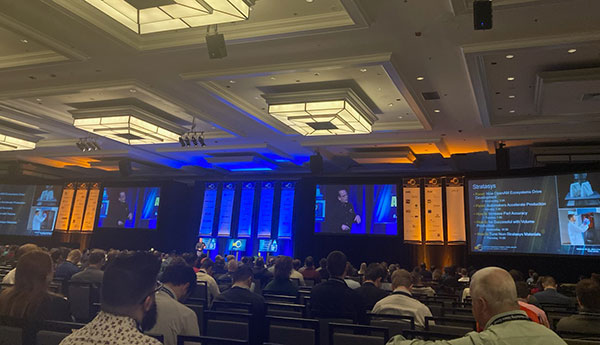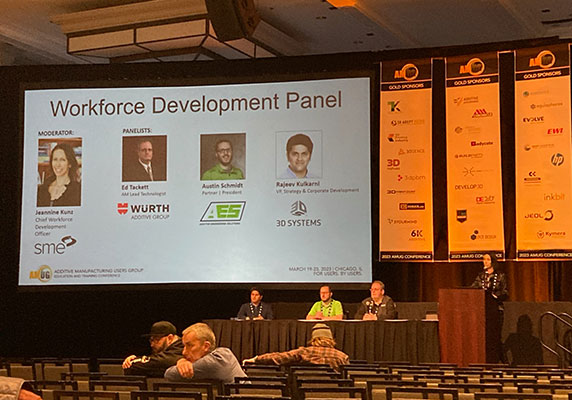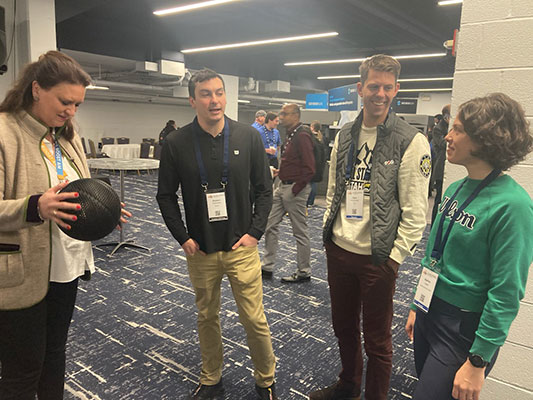Manufacturing New Connections
Event attendees get plugged in to additive manufacturing solution-making in the Windy City.

Approximately 2,000 attendees showed up to ponder new solutions in the additive manufacturing space at this year’s AMUG 2023 event.
Latest News
March 28, 2023
Stepping foot inside the Hilton Chicago for the Additive Manufacturing Users Group 2023 event in Chicago, March 19-23, 2023, it quickly becomes apparent that there is a distinct intentionality about everything that comprises the event.
From the AMUG-hosted sit-down meals where attendees draw numbers from a basket to determine their seating, to fist bumps and handshakes at keynote sessions, to interactive presentations involving canisters of Play-Doh and models of the heart, to built-in time for Q&A during the plethora of daily sessions, to a well-stocked open bar during evening exhibit hall expo time, one word underpins a big reason why guests (approximately 2,000 in attendance this year) keep returning year after year: Networking.
The event, which dubs itself as “for users; by users” brings together engineers, designers, educators and management professionals globally to share ideas, best practices, problems and application developments in an effort to work toward solutions in the additive manufacturing space. And the creative means to network at the event help transform ideas verbalized during, perhaps, a conversation in the exhibit hall to solutions folks can take back to the office and materialize.
Beyond special highlights at the event, including DINO awards, technical competition winners, announcements of board members, tours of local facilities, scholarship winners and much more, the event’s session tracks covered the gamut of material in the additive manufacturing space. Topics ranged from sustainable 3D printing, 3D printed phantoms, additive manufacturing in automotive, and metal additive post-processing to the future of the supply chain, developing the next-generation workforce, point-of-care manufacturing, additive standards, and dozens of topics beyond that.
“Our uniqueness at AMUG is about experienced people in additive coming together and being willing to openly share ideas, thoughts and experiences,” says Todd Grimm, former 9-year board member, DINO award recipient, AMUG team volunteer and this year’s emcee and additive expert. “That’s what makes this engine go. The way we fuel that engine is by the structure that we put together that facilitates networking. We’re networking on steroids.”

He admits not everyone who first comes into the event is keen on the networking aspect.
“Every year about 15% of first-time attendees come up to us and groan. We don’t want to pull a number. It’s stupid. We’re adults. But, 90% of that 15%, after doing that one time, will say that the networking is fantastic.”
Several attendees backed up his claim.
Dennis Fogle, founder and general manager, AM Pivot Service, West Des Moines, Iowa, has been coming for years to the event. The networking has proven a golden opportunity to get to know people at the events. For him, “Conversations that turn into a customer happen every year we attend AMUG.”
Nancy Leonard, design engineer of Ausco Products in Benton Harbor, Michigan, came to the event on a suggested whim from someone she knew. AMUG’s attention to newcomers got her attention. “They paid attention to 1st timers and were helpful [in] getting your footing to get the most out of AMUG. It’s not like anything I have ever been to… except Catia Operators Users Exchange from years back. It was refreshing to not be hammered with people wanting to sell you equipment and services but focused on making you smarter!”
Lisa Burt, engineering project manager, Caterpillar, in nearby Peoria, Illinois, is also a first-time attendee, who, until this year, was more familiar with the 3D printing event that takes place later in the spring, RAPID + TCT. She says the show has given her a new appreciation for the networking side of additive manufacturing.
State of Event
Though the pandemic did its part to initially set back in-person events, such as AMUG, Mark Abshire, current AMUG president, past DINO award recipient, and retired veteran of the industry, says that this meeting and particularly its timing in early spring serves as a gauge for the additive events that occur later in the year.
“It’s a measuring stick for the industry—have we recovered from the pandemic? It’s true that people have gotten used to working from home. The dynamics have changed,” says Abshire, who has attended AMUG annually since 1991 (missing just three years). The question AMUG set out to answer, “How many people want to come to a live event?” has proven fruitful in 2023. “We could not possibly do this as a video event.” In referencing online meetings when compared to AMUG, “You cannot make up for shaking hands and talking to people in person — it doesn’t work for us.”
And the networking, if working as AMUG intends, can ultimately lead to another outcome—working solutions. “Our biggest [goal] has always been meeting with other people who can offer solutions. Sharing ideas [leads to] sharing solutions. It’s easy to share problems. We want to share solutions.”
Abshire himself has been in the solutions business since the 1980s. Having started at Texas Instruments in its missile and weapons division, he began as a toolmaker working on laser-guided weapons systems. His career path led to work with the U.S. Air Force and eventually work on medical implants—specifically, titanium implants for soldiers that were used during Desert Storm. His work involved casting implants. That work eventually led to more altruistic work to help conjoined twins with prostheses. With the use of a 3D printer, he took the X-rays the doctors were using for the conjoined twins and reproduced them—albeit crudely—on his 3D printer.
“3D printing enabled [the doctors] to see something they didn’t (couldn’t) see on the x-ray,” Abshire says. That work with the medical team led Abshire, ultimately, to redirect his career path to the educational side. “And so I spent the last 20 of 30 years going around the world teaching people how to use the [3D printing] technology.”
Event Highlights

At the first of the keynote sessions, “Collaborations Between an Animator, an Architect, and a Surgeon: Keys to Impactful Innovations,” Rob Ducey, tech supervisor in the Rapid Prototyping Department of LAIKA Studios and Nicholas Jacobson MDes, architect/medical researcher at University of Colorado Anschutz Medical Campus, shared the stage to discuss some of their collaborative work.
“We’re only as good as the data that we start with. We are constantly working with people to develop more data in creative ways,” Jacobson says.
“Many surgeons are looking at data on a two-dimensional screen, Jacobson explains. If you are preparing for surgery, you're most likely going to get a CT scan and an x-ray MRI and they're going to look at your three-dimensional body on a two-dimensional screen, which is a series of two-dimensional images.”
At this point in the talk, Jacobson calls on the audience to take the piece of paper they were given when entering the session and were asked to draw either a heart or brain, depending on their location in the room.
“Being able to model complex features like this with a single piece of paper is difficult. It's very much like working with a mesh, right? Most of us are familiar with mesh surface based modeling. It's driven by equations very difficult to make,” Jacobson says.
Next, he had the audience take their can of Play-doh that they also received upon entry and now model that same brain or heart. “Hopefully this illustrates the idea that new modeling techniques allow you to model new things. You all can use very different techniques to model that heart and brain,” that you were unable to do with the piece of paper, Jacobson explains.
In their talk, the two highlighted how their collaboration has led to novel designs for pediatric epilepsy, cardiology, and cleft palate.
“We connected over a little-known 3D modeling and printing technique called bitmap printing. We have leveraged our unique workflows and toolsets from that connection to develop new and exciting applications for 3D bitmap printing in medicine,” Jacobson and Ducey said.
Taking It Home
Leonard of Ausco Products found some sessions practical enough to incorporate into her workflow back in Michigan. “GoEngineer and their printer hacks you wish you knew session was the bomb diggity!” she says. “There [were] a bunch of tips I gleaned from that session from part set-up in the printer clear up to post-processing and setting up the lab. But that isn’t the even gleaning the surface. Broadening and looking at other technologies being used and watching how people use and process materials there is something to be said about tips that cross all the technolog[y] boundaries.”
Throughout the event, sessions were divided into beginner, intermediate and advanced sessions to cater to wherever one may be at in their career path.
Later in the conference, a workforce panel that included Ed Tackett of Wurth Additive Group, Rajeev Kulkarni of 3D Systems and Austin Schmidt of Additive Engineering Solutions, dove into workforce training, retraining and development. The industry experts highlighted their experiences and difficulties with hiring employees and subsequently training them to work in additive manufacturing. Part of their talk addressed how universities can help foster and ready the next generation of workers in additive.

Schmidt of Akron, Ohio-based Additive Engineering Solutions, in addressing an attendee’s question about how to make a living as a tech in this profession, who essentially noted how additive techs are sometimes better off becoming Starbucks baristas for the paltry pay offered them in the manufacturing. In response, Schmidt says, “In our case, it comes down to how much can we pay and still operate a reasonable business?” He and other panelists noted the balancing act between paying well and running a sustainable business.
The exhibit floor, with more than 150 companies displaying the latest offerings in additive manufacturing from equipment to materials to unique services offered, was buzzing when open. Attendees could grab lunch or a drink while chatting and making connections with potential suppliers to their business. On the floor, the Wilson/EOS collaboration on the “basketball of the future” generated a decent share of chatter Meanwhile, Jabil, in a nearby salon was displaying its work on a bicycle helmet. While other companies, such as Materialise, were sharing news of new collaborations, such as its partnership with Sigma Additive. Those were just a few of the discoveries on the floor, among the materials, software and services updates on display.

Looking Forward
“What I celebrate about our event is its sameness — the vibe and energy, the quality of content, and importantly, the quality of people who are here. This is what scares me—if we grow too much, we run the risk of losing some of that quality that has built AMUG into what it is,” Grimm says.
Leonard of Ausco Products hopes to be part of the 2,000-plus attendees who come back in 2024. “There was so much to learn [that] next year I suspect will just be even more engaging. I loved the whole learning aspect of this— tips, learn, remind[ers} of the things once know[n] but forgotten and ‘by the way here’s all this cool new stuff to stir in the pot,’” she says.
“Our philosophy, strategy, style and personality—that’s what makes AMUG different.
With our board, committees—really with anyone involved—for any decision that has to be made, our first question is: how does this benefit our users?,” Grimm says.
More 3D Systems Coverage
More EOS Coverage
More Materialise Coverage
Subscribe to our FREE magazine, FREE email newsletters or both!
Latest News
About the Author
Stephanie is the Associate Editor of Digital Engineering.
Follow DE





